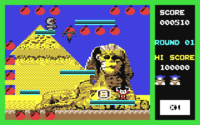Bomb Jack
| Bomb Jack | |
|---|---|
 | |
| Developer(s) | Tehkan |
| Publisher(s) | Tehkan |
| Designer(s) |
Michitaka Tsuruta Kazutoshi Ueda |
| Platform(s) | Arcade, Various |
| Release date(s) | 1984 |
| Genre(s) | Platform game |
| Mode(s) | Single player, 2-player alternating |
| Cabinet | Upright/Table-Top |
| Arcade system | Main CPUs: Z80 (4MHz) |
| Sound |
Sound CPU: Z80 (3.072MHz) Sound Chips: 3 × AY-3-8910A (1.5MHz) |
| Display |
Standard resolution raster Video: 256×224 60Hz |
Bomb Jack[1] is an arcade platform game that was released in 1984 by Tehkan (known today as Tecmo). It was followed by two official sequels, the console and computer title Mighty Bomb Jack, and the arcade game Bomb Jack Twin[2] and Bomb Jack II, which was licensed for home computers only.
Plot and gameplay

Bomb Jack is a hero who can perform high jumps and float in the air. His goal is to collect all red bombs on the screen. The game's antagonists are enemies such as birds and mummies which, once they drop in the bottom of the screen, can morph into things like flying saucers and orbs that float around the screen, making Jack lose a life if he touches them. Collecting bombs will increase the bonus meter at the top of the screen (collecting lit bombs increases it more). When the meter is completely filled up, a circular bouncing "P" appears, and when collected, it will turn all the enemies into bonus coins for a short period during which Jack may collect them. Other similar bonuses are the B (Bonus) which increases the score multiplier (up to 5x), the E (Extra) which gives an extra life, and the rare S (Special), which awards a free game. There are five different screens in the game, each featuring a distinct scheme of platforms (the fifth has no platforms at all). There is a special bonus for collecting 21 or more lit bombs in a row, out of the 24 bombs of each round.
Development


Bomb Jack was ported to various home computer systems from 1985 to 2009. A Java ME version was published in 2003.
- 1985: Sega SG-1000
- 1986: Amstrad CPC, Commodore 64, ZX Spectrum, Commodore 16
- 1988: Atari ST, Amiga
- 1992: Game Boy
- 2003: Java ME
- 2004: PlayStation 2 (Tecmo Hit Parade), MSX (Unofficial "homebrew")
- 2005: Xbox (Tecmo Classic Arcade)
- 2007: Wii Virtual Console (NES version)
- 2008: Atari XL/XE (Unofficial "homebrew")
- 2009: Wii Virtual Console (Arcade version)
- 2012: 3DS Virtual Console (NES version)
- 2014: PlayStation 4 (part of the Arcade Archives series), Wii U Virtual Console (NES version)
The Spectrum version of the game went to number 2 in the UK sales charts, behind Green Beret.[3]
Reception
Crash magazine gave the Sinclair ZX Spectrum version a 92% rating with the comment "A great arcade conversion, don’t miss it",[4] while Zzap!64 was less enthusiastic for the Commodore 64 version giving it 47%.[5] Commodore User gave the Amiga version 6 out of 10 citing that the Amiga should be well capable of doing better on a then four-year-old arcade game.[6] The Commodore 64 version used Jean-Michel Jarre's Magnetic Fields Part II.[5]
Legacy
Bomb Jack II is a licensed follow-up developed for 8-bit home computers by the British games publisher Elite Systems in 1986. The game went to number 2 in the UK sales charts, behind Leaderboard.[7]
Mighty Bomb Jack was released in 1986. The game was largely identical to the original game in almost all factors, except that the same screen layouts from the first game in the same sequence were now linked in a map-like continuous form by scrolling passages.[8] Mighty Bomb Jack got less favorable reviews than the original game.
Bomb Jack Twin was released in 1993 by NMK. In this version, two players could play simultaneously.
References
- ↑ Bomb Jack (ボンジャック Bon Jakku)
- ↑ "Bomb Jack". The International Arcade Museum. Retrieved 5 Oct 2013.
- ↑ "Your Sinclair Top Ten Games", Your Sinclair (7), July 1986, retrieved 2013-09-29
- ↑ "Review - Bomb Jack". Crash (27): 20–21. April 1986. Retrieved 2014-06-23.
- 1 2 "Review - Bomb Jack". Zzap!64 (28): 14. June 1986. Retrieved 2014-06-23.
- ↑ "Review - Bomb Jack". Commodore User (28): 14. June 1986. Retrieved 2014-06-23.
- ↑ "Your Sinclair Top Ten Games", Your Sinclair (17), May 1987, retrieved 2013-09-29
- ↑ Thomas, Lucas M. (2007-05-07). "Mighty Bomb Jack Review". IGN. Retrieved 2014-12-17.